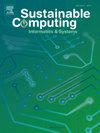Energy-efficient trajectory optimization algorithm based on K-medoids clustering and gradient-based optimizer for multi-UAV-assisted mobile edge computing systems
IF 3.8
3区 计算机科学
Q1 COMPUTER SCIENCE, HARDWARE & ARCHITECTURE
引用次数: 0
Abstract
The mobile edge computing system supported by multiple unmanned aerial vehicles (UAVs) has gained significant interest over the last few decades due to its flexibility and ability to enhance communication coverage. In this system, the UAVs function as edge servers to offer computing services to Internet of Things devices (IoTDs), and if they are located distant from those devices, a significant amount of energy is consumed while data is transmitted. Therefore, optimizing UAVs’ trajectories is an indispensable process to minimize overall energy consumption in this system. This problem is difficult to solve because it requires multiple considerations, including the number and placement of stop points (SPs), their order, and the association between SPs and UAVs. A few studies in the literature have been presented to address all of these aspects; nevertheless, the majority of them suffer from slow convergence speed, stagnation in local optima, and expensive computational costs. Therefore, this study presents a new trajectory optimization algorithm, namely ITPA-GBOKM, based on a newly proposed transfer-based encoding mechanism, gradient-based optimizer, and K-Medoids Clustering algorithm to tackle this problem more accurately. The K-medoid clustering algorithm is used to achieve better association between UAVs and SPs since it is less sensitive to outliers than the K-means clustering algorithm; the transfer function-based encoding mechanism is used to efficiently define this problem’s solutions and manage the number of SPs; and GBO is utilized to search for the best SPs that could minimize overall energy consumption, including that consumed by UAVs and IoTDs. The proposed ITPA-GBOKM is evaluated using 13 instances with several IoTDs ranging from 60 to 700 to show its effectiveness in dealing with the trajectory optimization problem at small, medium, and large scales. Furthermore, it is compared to several rival optimizers using a variety of performance metrics, including average fitness, multiple comparison test, Wilcoxon rank sum test, standard deviation, Friedman mean rank, and convergence speed, to show its superiority. The experimental results indicates that this algorithm is capable of producing significantly different and superior results compared to the rival algorithms.
基于 K-medoids 聚类和梯度优化器的多无人机辅助移动边缘计算系统节能轨迹优化算法
过去几十年来,由多架无人飞行器(UAV)支持的移动边缘计算系统因其灵活性和增强通信覆盖范围的能力而备受关注。在该系统中,无人飞行器充当边缘服务器,为物联网设备(IoTD)提供计算服务,如果无人飞行器距离这些设备较远,则在传输数据时会消耗大量能源。因此,优化无人机的飞行轨迹是最大限度降低该系统整体能耗的一个不可或缺的过程。这个问题很难解决,因为它需要多方面的考虑,包括停止点(SP)的数量和位置、它们的顺序,以及停止点和无人飞行器之间的关联。文献中的一些研究解决了所有这些方面的问题;然而,它们中的大多数都存在收敛速度慢、停滞在局部最优点以及计算成本高昂等问题。因此,本研究基于新提出的基于转移的编码机制、基于梯度的优化器和 K-Medoids 聚类算法,提出了一种新的轨迹优化算法,即 ITPA-GBOKM,以更精确地解决这一问题。与 K-means 聚类算法相比,K-medoid 聚类算法对异常值的敏感度较低,因此能更好地实现无人机和 SP 之间的关联;基于转移函数的编码机制可用于有效定义该问题的解决方案和管理 SP 的数量;梯度优化器可用于搜索最佳 SP,从而最大限度地降低总体能耗,包括无人机和 IoTD 的能耗。建议的 ITPA-GBOKM 使用 13 个 IoTD 实例进行了评估,IoTD 从 60 个到 700 个不等,以显示其在处理小、中、大规模轨迹优化问题时的有效性。此外,还使用多种性能指标(包括平均拟合度、多重比较检验、Wilcoxon 秩和检验、标准偏差、Friedman 平均秩和收敛速度)将其与几种竞争对手的优化器进行了比较,以显示其优越性。实验结果表明,与竞争对手的算法相比,该算法能够产生明显不同的优越结果。
本文章由计算机程序翻译,如有差异,请以英文原文为准。
求助全文
约1分钟内获得全文
求助全文
来源期刊

Sustainable Computing-Informatics & Systems
COMPUTER SCIENCE, HARDWARE & ARCHITECTUREC-COMPUTER SCIENCE, INFORMATION SYSTEMS
CiteScore
10.70
自引率
4.40%
发文量
142
期刊介绍:
Sustainable computing is a rapidly expanding research area spanning the fields of computer science and engineering, electrical engineering as well as other engineering disciplines. The aim of Sustainable Computing: Informatics and Systems (SUSCOM) is to publish the myriad research findings related to energy-aware and thermal-aware management of computing resource. Equally important is a spectrum of related research issues such as applications of computing that can have ecological and societal impacts. SUSCOM publishes original and timely research papers and survey articles in current areas of power, energy, temperature, and environment related research areas of current importance to readers. SUSCOM has an editorial board comprising prominent researchers from around the world and selects competitively evaluated peer-reviewed papers.
 求助内容:
求助内容: 应助结果提醒方式:
应助结果提醒方式:


